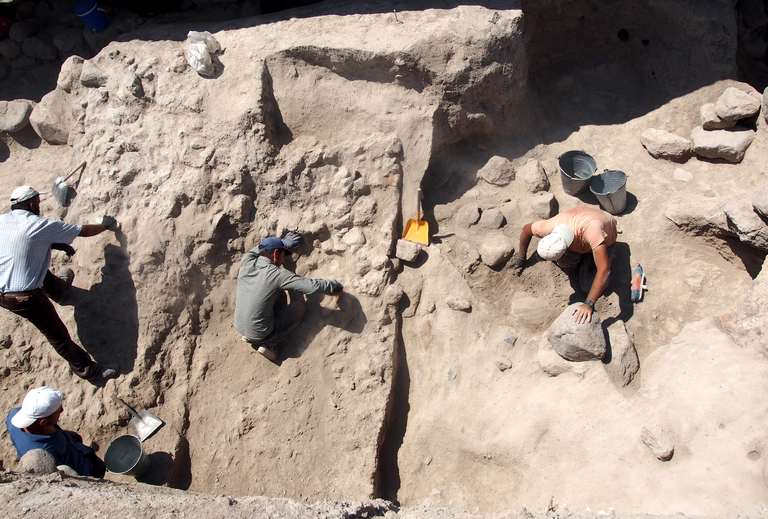Grain Storage and the Economy of Post-Hittite Polities
Lorenzo Castellano
PhD Candidate
This article first appeared in ISAW Newsletter 22 (Fall 2018).
 One of the silos from Kınık Höyük under excavation during the 2018 campaign
The Anatolian agricultural landscape is at the same time both rich and fragile: if soil productivity generally allows significant yields, below average fall and winter precipitation often causes major agricultural losses. Those problems are not new; they were recurrent throughout Anatolian history, and as such were confronted through an array of buffer strategies. Recent research has shown that with the establishment of the Hittite Kingdom (beginning in the 16th century BCE) those strategies reached an unprecedented scale and level of sophistication, with a centralized effort intended to minimize the agricultural risks inherent in such a challenging landscape. The two hallmarks of this program were large-scale storage facilities and hydraulic infrastructures such as water reservoirs and dams, discovered in the past few years in a number of Central Anatolian sites.
One of the silos from Kınık Höyük under excavation during the 2018 campaign
The Anatolian agricultural landscape is at the same time both rich and fragile: if soil productivity generally allows significant yields, below average fall and winter precipitation often causes major agricultural losses. Those problems are not new; they were recurrent throughout Anatolian history, and as such were confronted through an array of buffer strategies. Recent research has shown that with the establishment of the Hittite Kingdom (beginning in the 16th century BCE) those strategies reached an unprecedented scale and level of sophistication, with a centralized effort intended to minimize the agricultural risks inherent in such a challenging landscape. The two hallmarks of this program were large-scale storage facilities and hydraulic infrastructures such as water reservoirs and dams, discovered in the past few years in a number of Central Anatolian sites.
Together this infrastructural network, coupled with an underlying administrative structure, is to be understood as part of a planned economy aimed at extracting and accumulating large quantities of agricultural products (including grains such as barley and wheat). The recognition of this crucial role of staple finances in the Hittite Kingdom is a very recent achievement in the field. It is not surprising, therefore, that in the literature is still missing an analysis of what happened to this economic system after the fall of Ḫattuša, the capital of the Hittites in the early 12th century BCE. It leads to questions such as did this form of political economy disappear together with the Empire, or did it somehow survive the wave of changes taking place at the transition from the Late Bronze to the Iron Age?
In a recent study, to be published in a forthcoming issue of the Journal of Eastern Mediterranean Archaeology and Heritage Studies, I have attempted to answer these questions. The task is not easy, mainly because of a general paucity of sources and an overall lack of attention in the scholarship on the economy of post-Hittite polities.
In our favor comes the recent discovery of large-scale storage facilities at the site of Kınık Höyük, a mound in Southern Cappadocia excavated by a joint project of ISAW and Pavia University, under the direction of Professor Lorenzo d’Alfonso. This evidence consists of two large-scale underground silos, dated to the Early Iron Age and particularly remarkable for their dimensions and urban location. Leaving to the forthcoming article the description of those structures, it is clear that we are speaking of facilities built for the storage of very large amounts of crops, far above domestic demands, indicating the existence of an institution able to extract and administer large quantities of agricultural surpluses.
Epigraphic and archaeological data indicate the existence of other large-scale storage infrastructures, recalling the ones from Kınık, in other coeval sites. This evidence appears limited to the former southern and eastern peripheries of the Hittite Empire; hence, hardly a coincidence, in those regions in which continuity between Hittite and post-Hittite period has already been stressed. It appears, therefore, tempting to include centralized large-scale storage and the connected political economy among the distinctive features of Hittite tradition surviving in those regions the end of the Late Bronze Age—together with hieroglyphic writing, artistic style, and religious beliefs. Besides reinforcing the degree of continuity between the two historical phases, this recognition challenges us to rethink the nature and modality of transmission of Hittite heritage into the Iron Age.